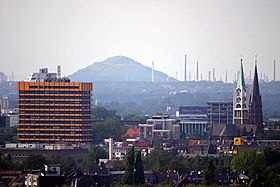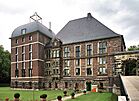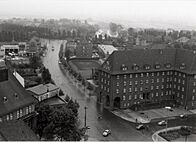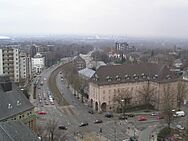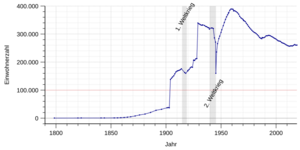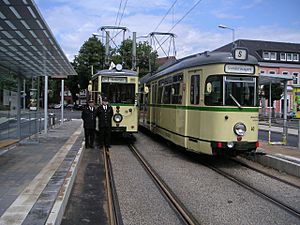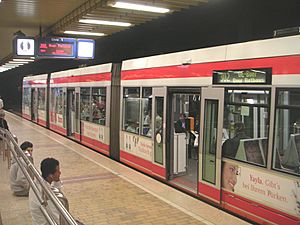Gelsenkirchen facts for kids
Quick facts for kids
Gelsenkirchen
Gelsenkiärken (Westphalian)
|
|||
|---|---|---|---|
|
Gelsenkirchen skyline, Arena AufSchalke, Musiktheater im Revier, Nordsternpark, Horst Castle
|
|||
|
|||
| Country | Germany | ||
| State | North Rhine-Westphalia | ||
| Admin. region | Münster | ||
| District | Urban district | ||
| Elevation | 60 m (200 ft) | ||
| Population
(2022-12-31)
|
|||
| • Total | 263,000 | ||
| Time zone | CET/CEST (UTC+1/+2) | ||
| Postal codes |
45801-45899
|
||
| Dialling codes | 0209 | ||
| Vehicle registration | GE | ||
| Website | gelsenkirchen.de | ||
Gelsenkirchen is a city in Germany. It's the 25th largest city in the country. It's also the 11th largest in the state of North Rhine-Westphalia. About 262,000 people lived there in 2016.
The city is located on the Emscher River, which flows into the Rhine. It's in the middle of the Ruhr area, which is Germany's biggest urban region. Gelsenkirchen is the fifth largest city in the Ruhr area.
Gelsenkirchen is famous for its football club, FC Schalke 04. The club is named after a part of the city called Gelsenkirchen-Schalke. Their stadium, Veltins-Arena, is a well-known landmark.
The city was first mentioned in records around 1150. But it was a very small village for a long time. In the 1800s, the Industrial Revolution changed everything. People started mining coal in 1840. The city grew very fast because of this. By 1900, Gelsenkirchen had 138,000 people.
In the early 1900s, Gelsenkirchen was Europe's most important coal mining town. People called it the "city of a thousand fires." This was because of the flames from mine gases burning at night.
In 1928, Gelsenkirchen joined with nearby cities like Buer and Horst. The city was called Gelsenkirchen-Buer for a short time. In 1930, its name changed back to Gelsenkirchen.
During World War II, Gelsenkirchen was a target for bombings. This was because it was a center for coal mining and oil production. Today, there are no more coal mines in the city. Gelsenkirchen is now looking for new ways to grow its economy.
A Journey Through Gelsenkirchen's Past
Early Settlements and Medieval Times
People lived in the Gelsenkirchen area a very long time ago. Hunters were here even before 1000 BC, in the Bronze Age. They lived in small groups of yards. Later, the Romans came to the area. Around 700 AD, the Saxons settled here.
Some parts of Gelsenkirchen today have names from the early Middle Ages. These include Resse, Middelich, Sutum, and Scholven. The name Gelstenkerken first appeared around 1150. Around the same time, the first church was built in Buer. In those days, only a few dozen people lived in the area.
The Rise of Industry
Until the mid-1800s, Gelsenkirchen was mostly farmland. In 1815, the area became part of Kingdom of Prussia. This was before Germany was a united country.
Then, in 1840, "Black Gold" was found! This was coal. The discovery of coal in the Ruhr area led to a huge growth in industry. Railways were built, connecting Gelsenkirchen to other cities. In 1868, Gelsenkirchen became an important administrative center.
Many factories were built here. Friedrich Grillo started companies for chemicals, ironworks, and glass. Gelsenkirchen became a major industrial city. In 1875, it officially became a city.
Becoming an Independent City
In 1885, Gelsenkirchen became the center of its own district. By 1896, it became an independent city. This meant it managed its own affairs. Buer also became an independent city in 1912.
In 1928, Gelsenkirchen, Buer, and Horst joined together. They formed a new independent city called Gelsenkirchen-Buer. In 1930, the name was shortened back to Gelsenkirchen. By this time, about 340,000 people lived here.
Companies in Gelsenkirchen also started making petrol from coal. This was an important industry.
Life During World War II
During the Nazi era, Gelsenkirchen was a target for bombing. This was because of its important factories. About three-quarters of the city was destroyed. Many old air raid shelters can still be seen today.
The city also had camps where people were forced to work. For example, a subcamp of the Buchenwald concentration camp was set up here. Around 2000 Hungarian women and girls were made to work against their will for a petrol company. There was also a camp for Sinti and Romani people.
The city's Jewish community faced terrible times. On November 9, 1938, during the Kristallnacht (Night of Broken Glass), Jewish businesses, homes, and synagogues were destroyed. Many Jewish people were forced to leave. By 1942, most of the remaining Jewish people were sent away. A new synagogue was opened in Gelsenkirchen in 2007.
Gelsenkirchen After the War
After World War II, Gelsenkirchen began to rebuild. In 1953, a new coking plant opened. Large power stations were also built. The city was given two postal codes in 1961, one for Gelsenkirchen and one for Buer.
In 1987, Pope John Paul II visited Gelsenkirchen. He held a large Mass for 85,000 people at the Parkstadion. He even became an honorary member of the FC Schalke 04 football club!
The last coking plant in Gelsenkirchen closed in 1999. The last coal mine closed in 2000. This meant the end of an era for Gelsenkirchen as a coal mining town. The city is now focusing on new industries, like solar energy.
Jewish Community in Gelsenkirchen
The Jewish community in Gelsenkirchen started officially in 1874. In 1880, about 120 Jewish people lived in the town. A synagogue was built in 1885. The community grew, and by 1933, there were 1,300 Jewish people.
During the Nazi era, Jewish life in Gelsenkirchen changed dramatically. Many Jewish businesses were closed. Jewish doctors lost their jobs. The Jewish community was expelled. Between 1937 and 1939, the Jewish population dropped from 1,600 to 1,000.
The synagogue was destroyed during Kristallnacht. Many Jewish people were forced to leave or were sent to other places. After World War II, 69 Jewish people returned to Gelsenkirchen. In 1958, a new synagogue and cultural center were built.
Today, the Jewish community in Gelsenkirchen has grown again. Many Jewish people from the former USSR moved to the city. A new, larger synagogue was built to serve the growing community.
Weather in Gelsenkirchen
| Climate data for Station Bochum, Gelsenkirchen (2019-2024) | |||||||||||||
|---|---|---|---|---|---|---|---|---|---|---|---|---|---|
| Month | Jan | Feb | Mar | Apr | May | Jun | Jul | Aug | Sep | Oct | Nov | Dec | Year |
| Record high °C (°F) | 16.6 (61.9) |
16.2 (61.2) |
19.3 (66.7) |
26.6 (79.9) |
27.8 (82.0) |
31.1 (88.0) |
35 (95) |
29.1 (84.4) |
30.5 (86.9) |
25.1 (77.2) |
18.2 (64.8) |
17.4 (63.3) |
35 (95) |
| Mean maximum °C (°F) | 6.6 (43.9) |
9.9 (49.8) |
12 (54) |
14.6 (58.3) |
20.5 (68.9) |
25.7 (78.3) |
23.9 (75.0) |
23.2 (73.8) |
24.3 (75.7) |
17.2 (63.0) |
11.1 (52.0) |
7.2 (45.0) |
25.7 (78.3) |
| Daily mean °C (°F) | 4.4 (39.9) |
7.0 (44.6) |
8.3 (46.9) |
10.1 (50.2) |
15.1 (59.2) |
20.3 (68.5) |
18.9 (66.0) |
18.2 (64.8) |
18.9 (66.0) |
13.5 (56.3) |
8.3 (46.9) |
5.2 (41.4) |
12.4 (54.2) |
| Mean minimum °C (°F) | 2.1 (35.8) |
4.3 (39.7) |
5 (41) |
6 (43) |
10.2 (50.4) |
14.3 (57.7) |
14.6 (58.3) |
14.4 (57.9) |
13.9 (57.0) |
10.6 (51.1) |
5.6 (42.1) |
3.1 (37.6) |
2.1 (35.8) |
| Record low °C (°F) | −7.9 (17.8) |
−3 (27) |
−3.6 (25.5) |
−1.4 (29.5) |
3 (37) |
8.5 (47.3) |
10.6 (51.1) |
10.5 (50.9) |
9.5 (49.1) |
3.7 (38.7) |
−3.4 (25.9) |
−7.5 (18.5) |
−7.9 (17.8) |
| Average precipitation mm (inches) | 89 (3.5) |
82 (3.2) |
98 (3.9) |
88 (3.5) |
96 (3.8) |
47 (1.9) |
144 (5.7) |
155 (6.1) |
59 (2.3) |
121 (4.8) |
84 (3.3) |
135 (5.3) |
1,198 (47.3) |
| Average rainy days | 21 | 19 | 19 | 19 | 14 | 7 | 22 | 19 | 12 | 20 | 22 | 22 | 216 |
| Source: Deutscher Wetterdienst | |||||||||||||
Gelsenkirchen's Economy and Transport
Gelsenkirchen is becoming a hub for solar technology. Companies like Shell Solar Deutschland GmbH make solar cells here. Other big businesses in the city include Gelsenwasser and Pilkington.
The city also has a popular zoo called ZOOM Erlebniswelt Gelsenkirchen. It was founded in 1949.
Getting Around Gelsenkirchen
Gelsenkirchen is well-connected by roads. Major highways like the A 2, A 40, A 42, and A 52 pass through the city. The Gelsenkirchen Hauptbahnhof (central station) is a key railway hub.
The Rhine–Herne Canal has a large commercial harbor in Gelsenkirchen. This harbor handles 2 million tons of goods each year. It's one of Germany's biggest canal harbors.
For local travel, Gelsenkirchen has trams and buses. These are run by companies like BOGESTRA. There are three tram lines, one light rail line, and about 50 bus routes.
News and Learning in Gelsenkirchen
Gelsenkirchen is home to local radio stations like REL (Radio Emscher-Lippe). The Westdeutsche Allgemeine Zeitung is the main local newspaper. There are also free weekly papers.
The city has many schools for all ages. There are 51 elementary schools and several middle and high schools. The Fachhochschule Gelsenkirchen is a university that offers courses in subjects like Computer Science and Engineering.
There's also a Volkshochschule for adult learning. The city library has three branches. The science park in Gelsenkirchen helps the city move from old industries to new ones like solar energy.
Culture and Fun in Gelsenkirchen
Gelsenkirchen has a rich cultural scene.
- The Musiktheater im Revier is a famous theater.
- The Kunstmuseum Gelsenkirchen is an art museum.
- You can explore the Industrial Heritage Trail to learn about the city's past.
- Nordsternpark is a large park built on a former coal mine.
- The city was part of Ruhr.2010, when the Ruhr area was a European Capital of Culture.
- The Rock Hard Festival is a popular music event.
Sports in Gelsenkirchen
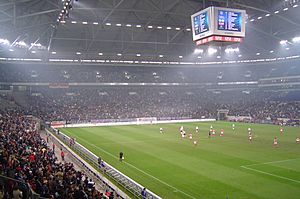
Gelsenkirchen is most famous for its football club, FC Schalke 04. They have won 7 Bundesliga titles. Their home stadium is the Arena AufSchalke. This stadium hosted matches during the 2006 FIFA World Cup. It will also host games for UEFA Euro 2024.
Many famous German football players were born in Gelsenkirchen. These include İlkay Gündoğan, Mesut Özil, Olaf Thon, and Manuel Neuer.
Gelsenkirchen also has a harness racing track called Trabrennbahn Gelsenkirchen. It has been open since 1912.
Famous People from Gelsenkirchen
Many interesting people were born or lived in Gelsenkirchen.
- Claire Waldoff (1884–1957) was a famous cabaret singer.
- Werner Mölders (1913–1941) was a legendary pilot.
- Harald zur Hausen (born 1936) won the Nobel Prize in 2008 for his work in virology.
- Gerd Faltings (born 1954) is a mathematician who won the Fields Medal.
- Tom Angelripper (born 1963) is a singer and bassist in a metal band.
- Terry Reintke (born 1987) is a politician and a Member of the European Parliament.
Sports Stars from Gelsenkirchen
- Ernst Kuzorra (1905–1990) and Fritz Szepan (1907–1974) were legendary footballers for Schalke 04.
- Norbert Nigbur (born 1948) was a goalkeeper who won the 1974 World Cup.
- Olaf Thon (born 1966) was a footballer who won the 1990 World Cup.
- Manuel Neuer (born 1986) is a famous goalkeeper who won the 2014 World Cup and multiple Champions League titles.
- Mesut Özil (born 1988) was a footballer who won the 2014 World Cup.
- İlkay Gündoğan (born 1990) is a footballer who has won leagues in Germany and England.
Partner Cities
Gelsenkirchen has "twin towns" or "sister cities" around the world. This means they have special friendly relationships.
- Zenica, Bosnia and Herzegovina (since 1969)
- Shakhty, Russia (since 1989)
- Olsztyn, Poland (since 1992)
- Cottbus, Germany (since 1995)
- Büyükçekmece, Turkey (since 2004)
- Newcastle upon Tyne, United Kingdom (since 1948)
Images for kids
See also
 In Spanish: Gelsenkirchen para niños
In Spanish: Gelsenkirchen para niños


